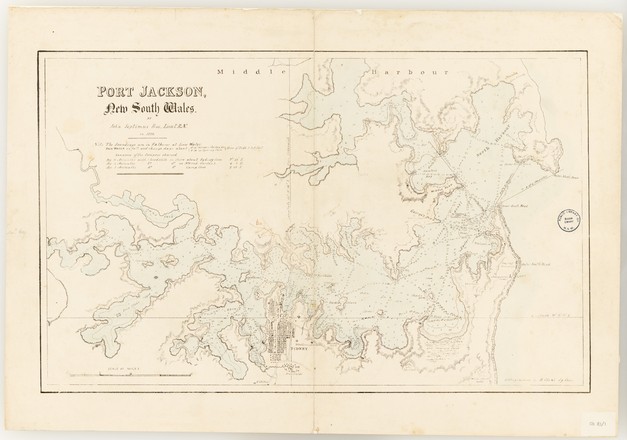Port Jackson, New South Wales
1822
Printed map
Sydney: Lithographed by R Clint, [182-?]
Bequest of Sir William Dixson, 1952
DL Z/Cb 83/1
In 1817 John Septimus Roe was posted as a master's mate to the surveying service in NSW, then under the command of Phillip Parker King. He arrived in the colony in September and over the next three years conducted three hydrographic coastal surveys, which included circumnavigating Australia. He was appointed lieutenant in April 1822, the same year he made this chart.
The chart provides a survey of Port Jackson from the Heads west to 'The Flats' (Homebush Bay). It shows the soundings, or the depth of the harbour, recorded in fathoms, tidal changes and the western and eastern channels near the entrance to the Heads.
A stellar career
John Septimus Roe is considered one of the most important surveyors of the Australian coastline. After an initial period based in NSW, where he produced a number of important charts and helped complete the work of Matthew Flinders in charting the Australian coastline, in 1824 he joined Captain James Bremer sailing north on the Tamar to Port Essington, establishing a settlement and taking possession of the northern coast of Australia. They continued on to the British Army’s base in India, where they saw action in the war against Burma. During this time, Roe prepared three charts of portions of the Arabian and African coasts. On his return to England, he was appointed by the Hydrographic Office to prepare The Australia Directory for publication in 1830, but in December 1828 he accepted the position of surveyor-general in the new colony of Western Australia (Swan River).
Roe arrived in Western Australia in June 1829. By the time he retired in August 1870, he had made a successful career as the new colony's surveyor-general, and through his service across a wide range of areas made a significant impact on the colony’s civic and cultural life. He was responsible of laying out the town plans of Perth, Fremantle and several minor towns, and by 1849 had made 16 voyages of exploration, mostly into the southern interior of the colony.



 Back to list
Back to list